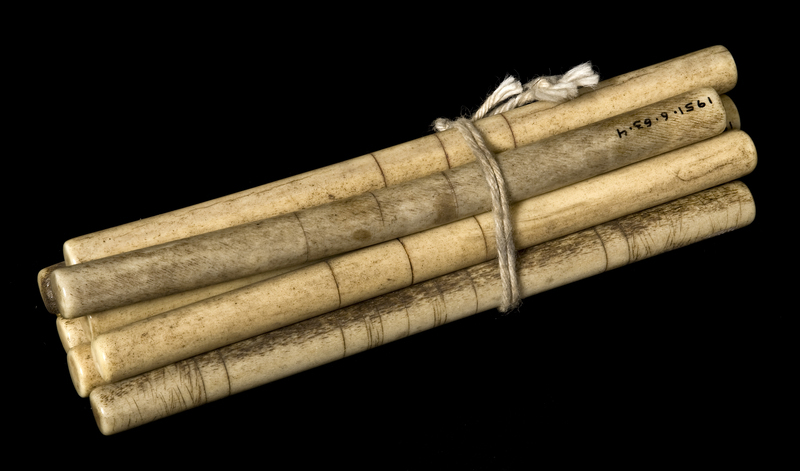Game Item Number: 1951.6.63 .1 - .9 from the Pitt Rivers Museum

Description
9 bone gambling sticks [.1- .9], part of set for guessing game.
Longer Description
9 bone gambling sticks [.1- .9], part of set for guessing game. Long cylinders of single pieces of bone, eight of which are incised with three thin lines encircling the stick near their centres. The ninth stick has the three central incised lines, plus additional pairs of lines incised nearer each end and scratched lines between the central three lines and at each end of the stick. A piece of cotton string loosely holds the sticks together as a bundle. [CAK 30/04/2009]
Research Notes
The following information comes from Haida delegates who worked with the museum's collection in September 2009 as part of the project “Haida Material Culture in British Museums: Generating New Forms of Knowledge”:
This gambling set was viewed alongside other gambling sets on Monday Sept 14, 2009. Christian White identified the material as whale bone. [CAK 20/05/2010]
Primary Documentation
Accession Book Entry - 'WELLCOME HISTORICAL MEDICAL MUSEUM, 28 PORTMAN SQUARE, LONDON, W.1...1951.6.63 HAIDA & TRIBES OF BRITISH COLUMBIA N. OF VANCOUVER ISLAND. Nine bone gambling sticks, part of set for guessing game - see P.R. coll. 3172 for instructions how to play. Length 11.5 cm. (164318)
There is no further information on the catalogue card. [CW 11 6 98]
Old Pitt Rivers Museum label - BRITISH COLUMBIA HAIDA & tribes N. of VANCOUVER ISLAND. Part of set for gambling game. [rev.:] Gift of the Wellcome Historical Medical Museum [El.B 'DCF 2004-2006 What's Upstairs?' 19/1/2005]
Related Documents File - Letter from E. Ashworth Underwood [Director, The Wellcome Historical Medical Museum] to T. K. Penniman dated 30 January, 1951, inviting the Pitt Rivers Museum to send a representative to select items from the Wellcome collection, housed temporarily at the British Museum. [GI 4/2/2002]
Related Documents File - The Haida Project Related Documents File contains video of research sessions and interviews with Haida delegates from September 2009 as part of the project ‘Haida Material Culture in British Museums: Generating New Forms of Knowledge'. It also includes post-visit communications that discuss object provenance. For extensive photographic, video, and textual records documenting the Haida research visit as a whole, including but not limited to preparations of objects for handling, travel logistics, British Museum participation, transcribed notes from research sessions and associated public events held at PRM, see the Haida Project Digital Archive, stored with the Accessions Registers. Original hand-written notes taken during research sessions have been accessioned into the Manuscripts collection, in addition to select other materials. [CAK 02/06/2010]
Item History
- Made in British Columbia Haida Gwaii NW Coast, Canada
- Received from Wellcome Historical Medical Museum during 1951
What
Who
- Culture
- Haida ?
- Received from
- Wellcome Historical Medical Museum
Where
- Holding Institution
- Pitt Rivers Museum
- Made in
- British Columbia Haida Gwaii NW Coast, Canada
When
- Acquisition Date
- during 1951
Other
- Keyword
- Game; Gaming Piece
- Class
- Toy & Game